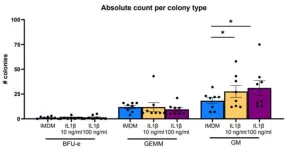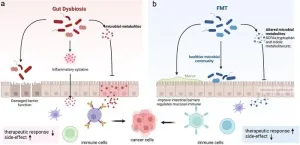(Press-News.org) Genes contain instructions for making proteins, and a central dogma of biology is that this information flows from DNA to RNA to proteins. But only two percent of the human genome actually encodes proteins; the function of the remaining 98 percent remains largely unknown.
One pressing problem in human genetics is to understand what these regions of the genome do—if anything at all. Historically, some have even referred to these regions as “junk.”
Now, a new study in Cell finds that some noncoding RNAs are not, in fact, junk—they are functional and play an important role in our cells, including in cancer and human development. Using CRISPR technology that targets RNA instead of DNA, researchers at New York University and the New York Genome Center searched across the genome and found nearly 800 noncoding RNAs important for the function of diverse human cells from different tissues.
“This survey of functional noncoding RNAs advances our understanding of the human genome and demonstrates the potential of CRISPR screens that specifically target RNA—even those that don’t code for proteins,” said Neville Sanjana, associate professor of biology at NYU, associate professor of neuroscience and physiology at NYU Grossman School of Medicine, a core faculty member at New York Genome Center, and the study’s senior author.
A more precise CRISPR for RNA
The gene editing technology CRISPR has revolutionized biomedical research, with widespread applications from enhancing crop production to treating blood disorders by editing the DNA in a person’s blood cells.
Most CRISPR applications use an enzyme called Cas9 to edit genes on the DNA level. However, a newer technology uses the enzyme Cas13 to more precisely target RNA without disrupting nearby protein-coding genes and other regulatory elements. Sanjana’s lab previously demonstrated how a CRISPR-Cas13 platform targeting RNA instead of DNA can be optimized to screen the whole transcriptome, or the genetic information transcribed into RNA molecules.
Many studies have used sequencing technology to read out what RNA is expressed, but it has been challenging to understand whether specific RNA molecules actually are required for cells to function.
“We now have this technology, but the biological question still remains: which parts of the noncoding genome are actually functional?” asked Simon Müller, the co-first author of the Cell study and a postdoctoral associate in Sanjana’s lab.
Not junk after all
Using CRISPR-Cas13 to edit RNA and avoid off-target activity, the researchers systematically profiled nearly 6,200 gene pairs of long noncoding RNAs (lncRNAs) and nearby protein-coding genes across five human cell lines, including kidney, leukemia, and breast cancer cells. They used CRISPR to perturb or knock down each lncRNA to see what happens—does the cell die, stop proliferating, or can it tolerate it?—and determine whether the lncRNA is essential.
“With Cas13, we can specifically ask, ‘What are the functions of those transcripts?’ They are not junk—we found that they are really important and essential to cells growing and dividing,” said Wen-Wei Liang, the co-first author of the Cell study and a postdoctoral associate in Sanjana’s lab.
The researchers identified 778 lncRNAs that are essential for cell function, including a core group of 46 lncRNAs that are universally essential and 732 with functions specific to certain cell types.
They then compared the essential lncRNAs to protein-coding genes. With the protein-coding genes, if a gene was essential in one of the five cell lines, it was likely to be essential in others. In contrast, the essential lncRNAs were more cell-type specific. The researchers were curious to know whether essential lncRNAs modulate protein-coding genes located nearby, a mechanistic question that had never been examined for noncoding RNAs. Here, they found that an overwhelming majority of essential lncRNAs operate independently of the nearest protein-coding genes.
The team also discovered that essential lncRNAs modulate key pathways for cell proliferation—a process that is important in both human development and cancer—and that their loss can impair the progression of cells and drive cell death. Notably, many essential lncRNAs were highly expressed across tissues early during human development and showed lower expression in the later stages, suggesting an important role for certain lncRNAs during development.
Moreover, in an analysis of roughly 9,000 tumors, the researchers found lncRNAs with altered expression in specific types of tumors, and pinpointed those lncRNAs whose expression in tumors were associated with better or worse survival in different cancers.
“These noncoding RNAs may yield new biomarkers and therapeutic targets for cancer treatment, a potential opportunity for personalized medicine given their cell type-specific expression,” added Sanjana.
Additional study authors include Sydney Hart, Hans-Hermann Wessels, Alejandro Méndez-Mancilla, Akash Sookdeo, Olivia Choi, Christina Caragine, Alba Corman, Lu Lu, Olena Kolumba, and Breanna Williams of NYU and the New York Genome Center. The research was supported by the National Human Genome Research Institute (DP2HG010099, R01HG012790), the National Cancer Institute (R01CA279135 and R01CA218668), the National Institute of Allergy and Infectious Diseases (R01AI176601), the Simons Foundation for Autism Research, and the MacMillan Center for the Study of the Noncoding Cancer Genome.
END
Finding function for noncoding RNAs using a new kind of CRISPR
RNA-targeting CRISPR reveals that hundreds of noncoding RNAs are essential—not “junk”—including in human development and cancer
2024-11-07
ELSE PRESS RELEASES FROM THIS DATE:
Neurodevelopment in the first 2 years of life following prenatal exposure to maternal SARS-CoV-2 Infection
2024-11-07
About The Study: In this longitudinal cohort study of multiple aspects of child neurodevelopment between ages 6 and 24 months, negligible associations between prenatal exposure to SARS-CoV-2 infection and child outcomes were observed. Follow-up research is warranted to determine whether these predominantly null effects persist into later childhood.
Corresponding Author: To contact the corresponding author, Gerald F. Giesbrecht, PhD, email ggiesbre@ucalgary.ca.
To access the embargoed study: Visit our For The Media website at this link https://media.jamanetwork.com/
(doi:10.1001/jamanetworkopen.2024.43697)
Editor’s ...
Racial disparities in genetic detection rates for inherited retinal diseases
2024-11-07
About The Study: Results from this study highlight a lower genetic detection rate for Black patients than for white patients with inherited retinal diseases. This supports a concern that the current development of inherited retinal disease therapeutics is highly dependent on the ability to identify the genetic cause of disease.
Corresponding Author: To contact the corresponding author, K. Thiran Jayasundera, M.D., email thiran@med.umich.edu.
To access the embargoed study: Visit our For The Media website at this link https://media.jamanetwork.com/
(doi:10.1001/jamaophthalmol.2024.4696)
Editor’s Note: Please see the article for additional information, including ...
Stem cells shed insight into cardiovascular disease processes
2024-11-07
When thinking about the immune system, most people think about B and T cells and how they can be trained to recognize pathogens, preventing re-infections. Besides this “adaptive” immune system, we also have an “innate” immune system which acts as first line defense against e.g. bacteria and viruses. The textbook view is that the innate immune system is non-specific so that it’s response always follows the same pattern, even for recurring infections. However, research published today in Stem Cell Reports provides evidence ...
New study: Plastics pollution worsen the impacts of all Planetary Boundaries
2024-11-07
“It’s necessary to consider the full life cycle of plastics, starting from the extraction of fossil fuel and the primary plastic polymer production” says lead article writer Patricia Villarrubia-Gómez at Stockholm Resilience Centre.
Plastics are not as safe and inert as previously thought. The new research article written by an international team of researchers uses the planetary boundaries framework to structure the rapidly mounting evidence of the effects of plastics on the environment, health and human wellbeing.
500 million tons of plastics are now produced yearly but only nine percent get recycled globally. Plastics are everywhere: ...
Long-term risks from prostate cancer treatment detailed in new report
2024-11-07
The risks of adverse effects and complications from treatment for prostate cancer are substantial and continue for years after treatment ends. The largest comprehensive analysis reporting long-term risks from such treatment relative to the risks faced by a control group of untreated men has just been published in the journal JAMA Oncology.
In the 12 years following treatment, men whose initial treatment was a prostatectomy (removal of all or part of the prostate) had a risk of urinary or sexual complications ...
Does more virtual care mean more low-value care? Study suggests no
2024-11-07
Before 2024 ends, Congress will decide whether to keep or change rules about telehealth, or let them expire. And even though the decision will focus on Medicare’s payment for virtual patient care, it will likely impact telehealth access for people with other kinds of health insurance too.
Now, a new University of Michigan study suggests that policymakers can rest easier about one of the top worries about telehealth: that virtual care will drive up the use of tests and scans that patients don’t need, wasting money and resources.
In fact, the study shows that low-value care didn’t rise faster at primary care practices that used telehealth the most, compared with those ...
City of Hope Research Spotlight, October 2024
2024-11-07
City of Hope® Research Spotlight offers a glimpse at groundbreaking scientific and clinical discoveries advancing lifesaving cures for patients with cancer, diabetes and other chronic, life-threatening diseases. Each spotlight features research-related news such as recognitions, collaborations and the latest research defining the future of medical treatment.
This roundup highlights the biology behind our sense of smell, real-world data that can be used to refine esophageal cancer treatment guidelines, a potential new approach to treating patients with type 2 diabetes, a new way to target pancreatic cancer ...
Increased focus on comorbidities, socioeconomic factors would help improve health equity for people with COPD
2024-11-07
Miami (November 7, 2024) – Health care providers treating people with COPD also need to focus on the person’s socioeconomic factors, along with considering their additional health conditions or comorbidities, according to a new article. The article is published in the September 2024 issue of Chronic Obstructive Pulmonary Diseases: Journal of the COPD Foundation, a peer-reviewed, open-access journal.
Chronic obstructive pulmonary disease (COPD) is an inflammatory lung disease, comprising several conditions, including chronic bronchitis and emphysema, and can be caused by genetics ...
Gut dysbiosis and fecal microbiota transplantation in pancreatic cancer: Current status and perspectives
2024-11-07
Pancreatic ductal adenocarcinoma (PDAC) is recognized as one of the most lethal cancers, with an estimated five-year survival rate of approximately 10%. This poor prognosis is largely attributed to the challenges in early diagnosis, aggressive tumor biology, and limited treatment options. Most PDAC cases are diagnosed at advanced stages due to its typically asymptomatic onset, making only a small percentage of patients eligible for potentially curative surgical resection. In recent years, increasing attention has been paid to the role of gut microbiota dysbiosis in PDAC, as ...
Prevalence of unrecognized cognitive impairment in socially and economically vulnerable older adults is high
2024-11-07
INDIANAPOLIS – One of the first studies to investigate the prevalence of unrecognized cognitive impairment among patients seen at Federally Qualified Health Centers, has found that it is ubiquitous, especially among minoritized older adults. These facilities provide primary care and preventive services regardless of ability to pay or health insurance status to more than 30 million patients, including a growing number of older adults.
Early and equitable detection of cognitive impairment can benefit patients and their families. Delaying diagnosis leads to poor health outcomes for patients ...
LAST 30 PRESS RELEASES:
Artificial saliva containing sugarcane protein helps protect the teeth of patients with head and neck cancer
Understanding the role of linear ubiquitination in T-tubule biogenesis
Researchers identify urban atmosphere as primary reservoir of microplastics
World’s oldest arrow poison – 60,000-year-old traces reveal early advanced hunting techniques
Bristol scientists discover early sponges were soft
New study uncovers how rice viruses manipulate plant defenses to protect insect vectors
NSF–DOE Vera C. Rubin Observatory spots record-breaking asteroid in pre-survey observations
Ribosomal engineering creates “super-probiotic” bacteria
This self-powered eye tracker harnesses energy from blinking and is as comfortable as everyday glasses
Adverse prenatal exposures linked to higher rates of mental health issues, brain changes in adolescents
Restoring mitochondria shows promise for treating chronic nerve pain
Nature study identifies a molecular switch that controls transitions between single-celled and multicellular forms
USU chemists' CRISPR discovery could lead to single diagnostic test for COVID, flu, RSV
Early hominins from Morocco reveal an African lineage near the root of Homo sapiens
Small chimps, big risks: What chimps show us about our own behavior
We finally know how the most common types of planets are created
Thirty-year risk of cardiovascular disease among healthy women according to clinical thresholds of lipoprotein(a)
Yoga for opioid withdrawal and autonomic regulation
Gene therapy ‘switch’ may offer non-addictive pain relief
Study shows your genes determine how fast your DNA mutates with age
Common brain parasite can infect your immune cells. Here's why that's probably OK
International experts connect infections and aging through cellular senescence
An AI–DFT integrated framework accelerates materials discovery and design
Twist to reshape, shift to transform: Bilayer structure enables multifunctional imaging
CUNY Graduate Center and its academic partners awarded more than $1M by Google.org to advance statewide AI education through the Empire AI consortium
Mount Sinai Health system receives $8.5 million NIH grant renewal to advance research on long-term outcomes in children with congenital heart disease
Researchers develop treatment for advanced prostate cancer that could eliminate severe side effects
Keck Medicine of USC names Christian Pass chief financial officer
Inflatable fabric robotic arm picks apples
MD Anderson and SOPHiA GENETICS announce strategic collaboration to accelerate AI-driven precision oncology
[Press-News.org] Finding function for noncoding RNAs using a new kind of CRISPRRNA-targeting CRISPR reveals that hundreds of noncoding RNAs are essential—not “junk”—including in human development and cancer




